What Are The Best Sleep Positions and Which One Should You Use?
How do you sleep at night? I don’t necessarily mean the quality of sleep, but the actual position you choose. Perhaps, though, the quality of sleep is important, because the position you choose can have a dramatic effect on how well you sleep. The best position for sleeping has been debated. Some prefer sleeping on their left or right side, others claim sleeping on their back is the best, and yet others suggest sleeping on your stomach or in some other position.
In truth, they all have positive and negative aspects, and other things factor in, such as sleeping surfaces and medical conditions. So, rather than figure out the best, let’s just learn about all of them.
Table Of Contents
- What Are The Best Sleep Positions and Which One Should You Use?
- 1. Sleeping on Your Side
- 2. Sleeping in the Fetal Position
- 3. Sleeping On Your Stomach
- 4. Sleeping on Your Back
- Other Factors
- 1. Side Sleepers
- 2. Back Sleepers
- 3. Stomach Sleepers
- Changing Your Sleeping Position
- Pillows
- Readjusting
- Consider Options
- Sleeping and You
What Are The Best Sleep Positions and Which One Should You Use?
1. Sleeping on Your Side – Editor's Choice

Pros
- Helps with Spinal Alignment
- Aids Digestion
- Avoids Sleep Apnea
- Reduces Snoring
Cons
- Premature Wrinkles
- Shoulder Pain
- May Put Your Arm to Sleep
You may not realize this, but sleeping on your side is a fantastic position in which you can sleep. The best benefits come, in particular, if you sleep on your left side, and that comes down to our anatomy.
Think about your internal organs. The left side of our body is where our stomach lives. Housed within is a whole bunch of gastric juices. This acidic stuff is what helps your food digest. It’s also what can contribute to terribly annoying things such as heartburn and acid reflux.
Fortunately, if you’re sleeping on your left side, the liquid stays perfectly contained within. On the other side, however, you have a better chance of interrupted sleep thanks to the stomach acid potentially sliding down your esophagus and into your throat and mouth. Not a good way to wake up.
Those who suffer from sleep apnea will also find sleeping on their side to be ideal. When in this position, your airway is allowed to be more open, making it easier to breathe without having obstruction issues which can be commonplace when sleeping on your back or stomach. It can also cut down on snoring for the same reason.
Additionally, sleeping on your side can help with your spinal alignment. With a properly fluffed pillow to support your head and neck, sleeping on your side can get your spine lined up very well so long as you are able to keep your legs and torso straight. This can be a little more difficult for people who are on the bigger side, but it’s still possible, particularly with a mattress which has a little give to it.
There are a couple of downsides which come with sleeping on your side. Since you’re laying on your shoulder, and putting all your weight on it throughout the night, you run the risk of developing shoulder pain over time. This can be remedied to some extent by not always sleeping on the same side of your body.
Sleeping on your side can also cause you to wake up with paresthesia, which isn’t nearly as scary as it sounds. That’s that feeling of your limb falling asleep, with that pins-and-needles sensation. Many people who sleep on their side may keep their arm under them or under their head. This works, but it can lead to the aforementioned issue from time to time.
Some also suggest sleeping on your side can lead to issues with wrinkles. Since your face is constantly pressed up against a pillow, the added pressure can stretch your skin, leading to crow’s feet a bit earlier than one might like. By one count, approximately fifteen percent of the adult population prefers to sleep on their side.
2. Sleeping in the Fetal Position
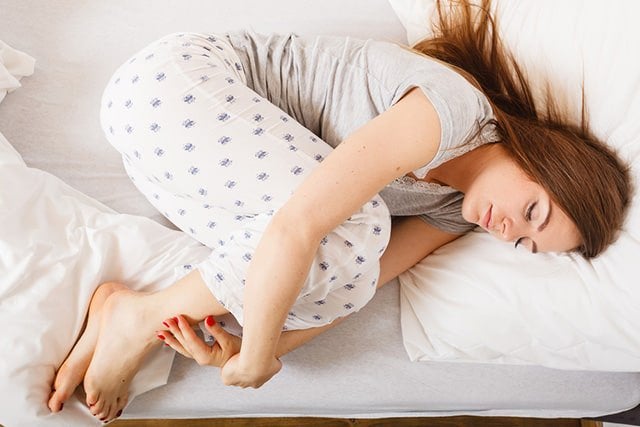
Pros
- Excellent for Pregnancy
- Combats Snoring
- Aids Digestion
Cons
- May Restrict Breathing
- Potential for Joint Pain
This is going to be a fairly small section, because sleeping in the fetal position bears many of the same benefits seen with sleeping on your side, seeing as they’re basically the same thing. Instead of your body being straight, however, you curl your legs up toward your body and curve your back into a sort of a hunched over position.
Apparently, 41 percent of the population enjoys this position, making it the most popular, but it isn’t exactly good for you. Well, not unless you’re pregnant. In the case of pregnancy, sleeping in this position helps to increase circulation through the body and the fetus within and keeps the uterus from pressing against your liver. These are definite plusses. However, the position also can lead to some real soreness in the morning.
Putting yourself in the fetal position puts stress on the muscles in your back, and can be especially uncomfortable for those who suffer from arthritis. On top of this, curling your body in this way also keeps the diaphragm from doing its job to the best of its ability, which means your breathing can end up being affected as you sleep.
Still, this position does combat snoring, it does fight sleep apnea and keep those awful stomach acids in check.
3. Sleeping On Your Stomach

Pros
- Reduced Snoring
Cons
- Back Pain
- Muscle Pain
Do you sleep on your stomach? You may want to rethink that idea. Of all traditional sleeping positions, sleeping on your stomach is pretty much the worst save for one thing: stopping snoring. If you are a heavy snorer in any other position, sleeping on your stomach is going to help out with that. This is because all the things which usually get in the way during sleep and cause the snoring will be out of the way when sleeping on your stomach. Clear airways mean clear breathing which means little to no snoring.
However, sleeping on your stomach comes with a host of negative side effects. The shape of your body keeps you from having a straight spine as you sleep in this position. You’ll be literally bent a bit out of shape, and by morning you’re going to find yourself wishing you had slept another way. If you typically sleep this way and end up waking up in pain, now you know why. There’s no good way to keep your spine in a neutral position while sleeping on your stomach.
If that’s not bad enough, sleeping in this position puts a lot of pressure on muscles and joints, which can lead to irritation and pain. Just think about it. Your spine is going to be curved because of where it connects to your neck and how you have to keep your head while sleeping. Unless you have a special pillow, sleeping face down isn’t exactly an option, and sleeping with your head turned means your neck is going to be bent all night long. This is not a recipe for restful sleep.
With this in mind, it’s no surprise only about seven percent of the population choose this way to sleep.
4. Sleeping on Your Back
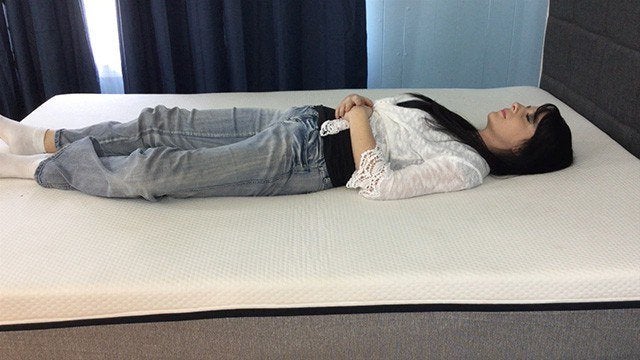
Pros
- Great for Posture
- Reduced Joint and Muscle Pain
Cons
- Terrible for Sleep Apnea
- Terrible for Snorers
While only eight percent of people sleep on their back, the number should be much higher, seeing as it is arguably the best position the average person can use. There are a couple caveats, but overall, I think you’ll agree this position is pretty fantastic.
First off, it’s great for your spine and overall posture. Think about it, if you’re lying on your back, your spine is straight, and a good mattress will allow for the natural curvature to have support, though sleeping on a firm mattress, a futon, or even the floor will do, thanks to the fact your spine can support itself. By lying on your back, your spine is in a neutral position without anything pressing against it to push it out of shape. This is a good thing and one which will be more likely to have you waking up without pain.
Secondarily, you can still avoid many of the digestive issues which can come from sleeping on your stomach, for instance, you’ll just need a decent enough pillow which can keep your head elevated, making sure it’s not below your throat, which could potentially allow acid to escape from your stomach and into your esophagus. Again, not a comfortable sensation to experience.
It should be noted, however, this is not a good position for anyone who suffers from sleep apnea, and it will cause snoring. Your back is going to feel great, but the rest of you will be completely thrown off if your breathing becomes blocked due to issues with obstructive sleep apnea. Since the issue with sleep apnea comes from the fatty tissues in your throat obstructing the breathing passage, sleeping on your back makes it easier for those pieces of your throat to fall into place and block the air. This can lead to issues with breathing, potentially causing you to stop breathing entirely.
Should the blockage be bad enough, it would jolt you awake. It is for this reason many people with sleep apnea don’t get restful sleep. Constantly waking up in the middle of the night isn’t conducive to that, and many people with sleep apnea don’t even realize it’s happening.
You May Be Interested In: How Many Pillows Should You Sleep With?
Other Factors
Now, let’s be honest, unless you’re sleeping out in the wild, without a pillow or blanket, there are other things which need to be taken into consideration when choosing which sleeping position is going to be the most comfortable .For instance, if you enjoy sleeping on your back, you’re going to want to make sure to have a pillow with a little bit of height to it so as to keep your head elevated. If you want to sleep on your stomach, you might prefer something a bit softer in the mattress department. Let’s take a look at what are considered the best options for each of the sleeping positions.
1. Side Sleepers
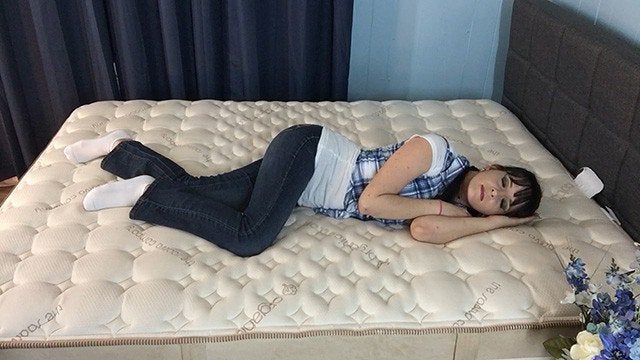
Those who prefer to sleep on their side are going to want to go for a slightly softer than average mattress. This will allow it to match the natural curvature of the body in order to keep things nice and straight so far as the spine is concerned. With something such as memory foam, this also means the rest of the body will have a fair amount of support, assuming the inner layers of the mattress are able to provide this.For something like this, a memory foam mattress at a medium level of firmness would be ideal, one with a fair amount of support from something such as high-density foam or pocketed innersprings. Going with this, the mattress would still be comfortable for other people sleeping in the bed as well, assuming they may have other sleeping positions. Overall, this is sort of the best bet for everything mattress, though it’s perfect for a side sleeper.
For your head, you’re going to want something which doesn’t have too much loft, which can put your head too high and remove the desired alignment in your spine. So aim for firmness, but not necessarily thick. You have to consider a couple other facts, as well. There are some pillows out there which, for instance, have pockets to accommodate for your ear, which can make sleeping a bit more comfortable. Others are designed to conform.
You can get pillows made out of memory foam, with varying levels of firmness, but there are alternatives to this, as well. Pillows which contain small items inside, such as buckwheat hulls or small beads, can also help your pillow match your head perfectly, and without the heat issues sometimes associated with memory foam.
You may be interested in: Are Adjustable Beds Good for Side Sleepers?
2. Back Sleepers
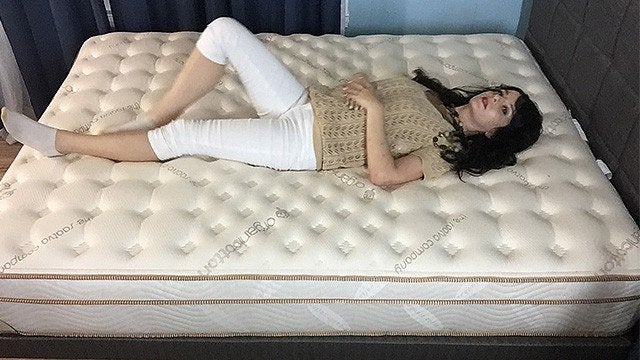
Since sleeping on your back is one of the best ways to make sure your spine and such stay aligned, you don’t need a whole lot of give in your mattress. Back sleepers are going to have their best results using a slightly medium to medium firm mattress. If you go too soft, you’ll start having more curvature in your back than you’d like. This can be found in memory foam, latex foam, or pretty much any variety of mattress.For your head, you want a pillow which is just thick enough to elevate your head so you won’t have any acid making its way back into your throat and mouth. This is especially important for those who suffer from acid reflux disease and other similar maladies. Foam pillows can be a great option, as would the pillows filled with small objects, but it doesn’t matter all that much. For this situation, the key is really trying to get that extra height.
3. Stomach Sleepers
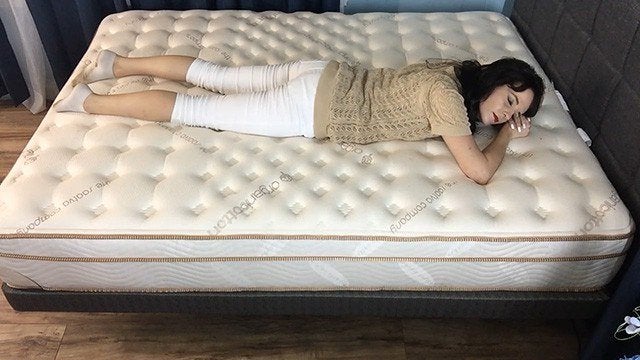
While sleeping on your stomach isn’t really good for anyone, some people simply won’t be able to change their ways. To each their own, it is said. For these people, the right mattress can help with some of the issues they may face. You don’t want to go too soft, for instance, because it’ll mess up the alignment of your spine. However, if you go too firm, you risk causing yourself some aches and pains in the morning from the pressure your body puts on your chest. On the pillow side of things, there’s only one pillow to be used if you plan on making the most of sleeping on your stomach and staying alive. You’re looking for a pillow which either has a place for your face or which can hold up your forehead, so you can sleep face down and not suffocate.
It really does come down to just that. Sleeping on your stomach with your neck turned is a recipe for soreness. If you absolutely must sleep that way, however, keep in mind the same things you would if you were sleeping on your side.
You may be interested in: Sleeping on the Floor: Bad or Good?
Changing Your Sleeping Position

Again, we know sleeping on your stomach isn’t your best option, but can you simply change the way you prefer to sleep overnight? No, not really. Once you get used to a sleeping position, you’re going to find yourself waking up that way most of the time, whether or not you want to. Fortunately, your sleeping position can be changed, but it’s going to take a little work, a little time, and a lot of patience.
Pillows
If you want to start sleeping on your side, few things are as easy as limiting your movement. One way to do this is to place a pillow behind you when you get into bed. This is going to make it more difficult to roll over onto your back or stomach in the middle of the night. By doing this, you’re forcing your body to stay in this position. You can take this a step further by using either a contouring pillow or one of those full body pillows. By using a pillow such as this, you can shape it around your body, and even put your arms around it, to sort of lock yourself comfortably in place. In time, you may not need to resort to such methods, but maybe you’ll stick with it because it’s so darn comfortable.
Readjusting
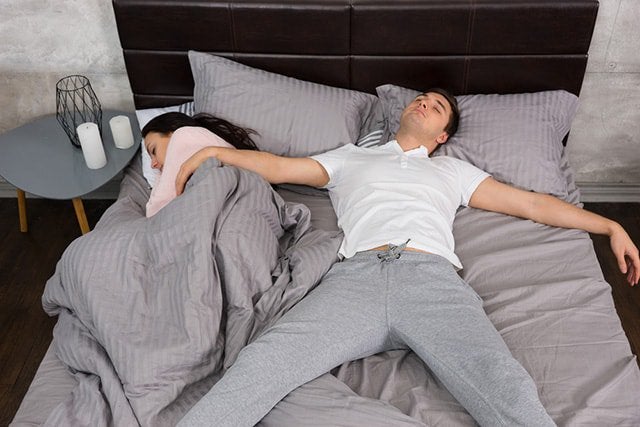
We don’t all wake up in the middle of the night, but if you’re trying to change sleeping positions and do wake up, pay attention to how you did so. If you went to sleep on your back or side but found yourself on your stomach, your body is changing its position as you sleep. In cases such as these, simply put yourself back into the desired position and give sleep another go. It’s going to take some patience and time, but it can be done.
Consider Options
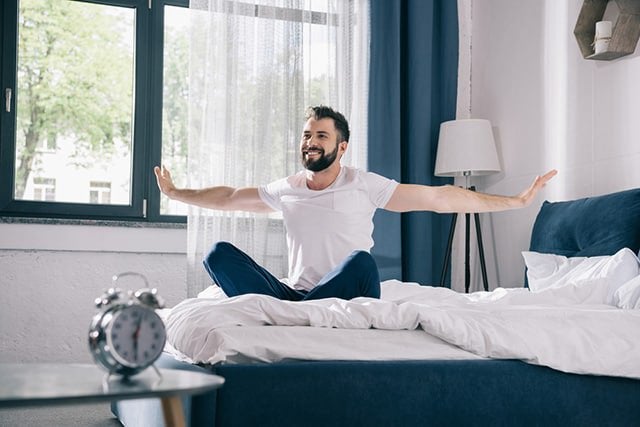
Looking at everything here, you know some positions are better than others at certain things, but what about how you yourself feel? If you like sleeping on your stomach and find yourself waking up feeling great each morning, maybe you don’t need to change your sleep position at all. Maybe all you need to do is keep doing what you’re doing and consider a change if, at some point in the future, the status quo changes. Only you can really tell what you need. Pay attention to your body, it has all the answers.
Sleeping and You
Whether you sleep on your back, your side or your stomach, or some variation in between, your sleep position is kind of a big deal. Your aches and pains may not be from the stresses of life, they could stem completely from the way in which you sleep and from the items on which you sleep.
Consider taking a deeper look at what your body does each night and see if a change is in the cards for you. If so, all it takes is the will to make a change, and you could be enjoying even more peaceful sleep in the future. What do you think? Any questions or comments? Please comment and share below!
